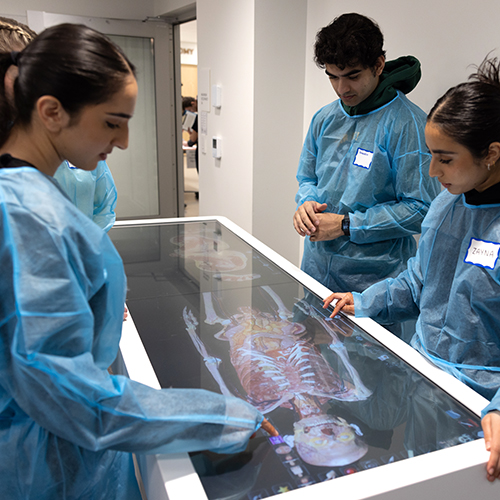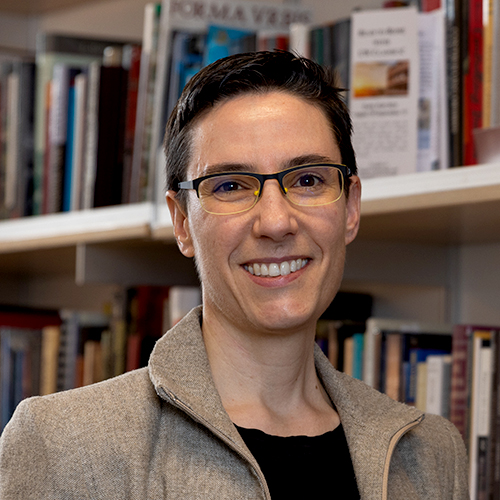Ivana Bozic liked high school.
Growing up in Belgrade, Serbia, she attended a high school for students interested in mathematics. She aced math and physics competitions. When she enrolled at the University of Belgrade, she majored in math, thinking she’d be a research mathematician.
But the more advanced she got in her math studies, the more abstract the concepts got. She started to wonder what else was out there.
Toward the end of her undergraduate studies, Bozic had an opportunity to study bioinformatics as part of an internship at the Institute for Infocomm Research in Singapore. Bioinformatics—with its integration of math, computer science and biology to address biological questions—interested Bozic because of its application of math to something more tangible, something which could influence health and medicine.

After receiving both her bachelor’s and master’s degrees in mathematics from the University of Belgrade, she sought graduate programs outside the country that incorporated both math and biology. She earned a Ph.D. in math from Harvard, where she pursued applied math in mathematical biology and cancer modeling. After completing postdoctoral work at Harvard, she joined UW.
One of the things that attracted her was UW’s focus on applied math.
“At first, I wanted to do pure math, to prove theorems and create new mathematics. Then later on, applied math, with its more immediate potential to affect the real world. One isn’t better than the other; they’re just different. I see the positives of both approaches. UW has both strong applied math and strong biology programs, not to mention excellent cancer research at UW Medicine and at Fred Hutch. It felt like it would be a good match for me,” she says.
Benjamin Kerr, professor in the UW Department of Biology, has been collaborating with Bozic on a project in bacterial evolution. “She uses math as a creative enterprise and sees fundamental connections. She takes an abstract set of principles and applies that knowledge to biological processes, which can have deep impact on health. Ivana is a phenomenal colleague, teacher and researcher. I know she’s going to do exciting things,” he says.
Mistakes were made
Our cells are constantly dividing. It happens billions of times every day, everywhere in our body. And every time a cell divides, it has to copy its genome: its complete set of genetic instructions with all the information needed to build and develop it. But when a cell divides and copies over the genetic information, it doesn’t always happen flawlessly. DNA replication isn’t perfect. Mistakes get made.
“Our cells are constantly becoming different from each other,” Bozic says. “On average, each time a cell divides, one new mutation will occur.”
Most of these mutations are harmless. Those are called “passenger” mutations; like a passenger, they’re passive, just along for the ride. They accrue without producing a notable effect, says Bozic.
But then there are the “driver” mutations, which can become more problematic. If an error occurs in replication, that error then gets copied for the new cells created. As cells divide, their progeny collect more mutations.
“Typically, several driver mutations are needed for the development of solid cancers in adults,” says Bozic. “But some leukemias and childhood cancers can be caused by a just a single mutation.”
These mutations are often stochastic, or randomly determined. They can be analyzed using probabilistic and statistical techniques, but they can’t be precisely predicted.
Cancer, Bozic says, can be seen as an evolution within our body. And like evolution, it’s not something we can see happen at the moment it’s happening. She applies mathematical approaches to understand how cancer evolves.
“We have cells that are stochastically acquiring mutations. Some of them can be really bad. How can we measure a process that can’t be observed in humans? Math is a powerful tool to try and understand that process. We can use math, along with clinical observations, to infer what is happening,” she says.
We have cells that are stochastically acquiring mutations. Some of them can be really bad. How can we measure a process that can’t be observed in humans? Math is a powerful tool to try and understand that process. We can use math, along with clinical observations, to infer what is happening.
Not only is Bozic interested in understanding the evolution of cancer as it’s occurring, but she’s also drawn to learning how we can harness this mathematical knowledge to influence how we treat cancer. Can math be used to design more effective treatments?
Counting rings— biologically
In recent years, medical research has brought a surge of DNA sequencing of all kinds, including cancer sequencing. This can reveal the types of genetic mutations present in a patient’s cancer. This, along with math, can indicate how long a cancer has been developing in the body, even if it was only recently diagnosed. This is an important question because that can affect efforts toward early detection.
“When you use math to estimate how long a cancer has been present in the body, often you find that it’s been developing for decades,” she explains. “We can learn this by looking at the genetic mutations we find, account for the mathematical model of how they likely accumulate, and then calculate how long a tumor was actually present.”
This scientific version of counting rings on a tree to determine its age and history can provide clues about how to detect cancers earlier, before they become more complicated to treat or lethal.
Math can also help scientists develop more effective treatments, Bozic says. For example, adjustments to targeted therapy, a type of cancer treatment specific to some mutations in cancer cells. Targeted therapies are drugs that target specific genes and proteins involved in the proliferation of cancer cells. At first, targeted therapy showed huge success for some, but then the shrunk or vanished tumor would reappear. This may have a mathematical basis, says Bozic.

“Most tumors bigger than a centimeter have pre-existing resistant cells,” she says. “Our calculations show this is because cells mutate to have resistance to certain treatments: A drug will kill some cells, but not the ones that are resistant. Then those cells will replicate.”
To treat cancer using targeted therapies, sometimes one drug will be given at a time and then another swapped in its place if it appears to stop working. But what may work better is giving a combination, all at the same time, to give a patient a stronger chance of conquering those pre-existing resistant cells, Bozic believes.
“A one-centimeter tumor has about a billion cells and a billion different mutations. Some of those mutations will confer resistance to treatment,” she says.
Immunotherapy
Immunotherapy is a type of cancer treatment that harnesses the body’s immune system to fight cancer. Bozic is studying how best to use math to optimize immunotherapy. She’s hoping to learn more about the dynamics of different kinds of immunotherapies and how they work with the genetics of a patient’s cancer, for different kinds of cancer, including melanoma, leukemia, and lymphoma.
She recently published a paper on CAR-T cell therapy, in which a patient’s T-cells, part of the immune system, are taken out of their body during a blood draw, engineered to better fight cancer, and then put back in their body.
“Chemotherapy is usually given to patients prior to CAR-T therapy,” she explains. “But our initial investigations are showing that if you could give the same amount of chemotherapy over a longer period of time and shorten the timespan between the end of chemo and the start of this treatment, that might make a difference in the number of patients that respond.”
Another research project of Bozic’s focuses on the genetic basis of colorectal cancer—work which has earned her a CAREER grant from the National Science Foundation to quantify how colorectal cancer evolves. She studies how specific genes mutate at specific rates through a detailed mathematical model. This could inform efforts to detect colorectal cancer DNA in the blood, an exciting and relatively new technology called cell-free DNA—which could be used for early detection, she says.
“This way we can see how colorectal develops over years and decades and figure out at which point it would be beneficial to try and screen early,” Bozic says.
The future of personalized therapy and precision oncology is to ask, ‘We have this cancer with this attribute: Can we can predict how it will behave?’ It’s a big question, but I think math can help answer it.
Professor Bozic was also selected as the 2021 Mathematics recipient in the Johnson & Johnson Scholars Award Program, an international competition which awards and sponsors women at critical points in their careers in each of the STEM2D disciplines: Science, Technology, Engineering, Math, Manufacturing, and Design. These awards are given to women early in their careers and provide $150,000 over three years toward their research.
She adds, “The future of personalized therapy and precision oncology is to ask, ‘We have this cancer with this attribute: Can we predict how it will behave?’ It’s a big question, but I think math can help answer it.”
More Stories

The Impact of Anatomy Lessons
Anatomy for Change, a program for students underrepresented in healthcare careers, provides opportunities to spend time in an anatomy lab.

What the Sky Teaches Us
Brittany Kamai, an astrophysicist with knowledge of Pacific Islanders' Indigenous navigation using the sky, is teaching a new UW course, Pacific Indigenous Astrophysics.

Lifting Marginalized Voices — from Ancient Rome
"Interesting, frustrating, and necessary,” is how Sarah Levin-Richardson, professor of Classics, describes her research into the lives of enslaved individuals in the ancient world.